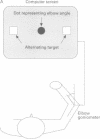Abstract
OBJECTIVE--To design a test of motor learning using arm movements in normal subjects and patients with cerebellar disease. METHODS--Elbow angle was continuously displayed as a cursor (a dot) on a computer screen, and subjects made ballistic elbow flexion and extension movements to try to move the cursor between two targets on the screen. The relation between the arm movement and its visual feedback was changed, and the subjects reacted by adapting the amplitude of their movements in subsequent trials. RESULTS--The consecutive errors showed exponential learning curves during adaptation, which were quantified by their steepness. Ten patients with isolated cerebellar or olivopontocerebellar degeneration had less steep learning curves than normal subjects, indicating a failure of adaptation motor learning in cerebellar disease. The results show that this test may be useful for the analysis of motor learning.
Full text
PDF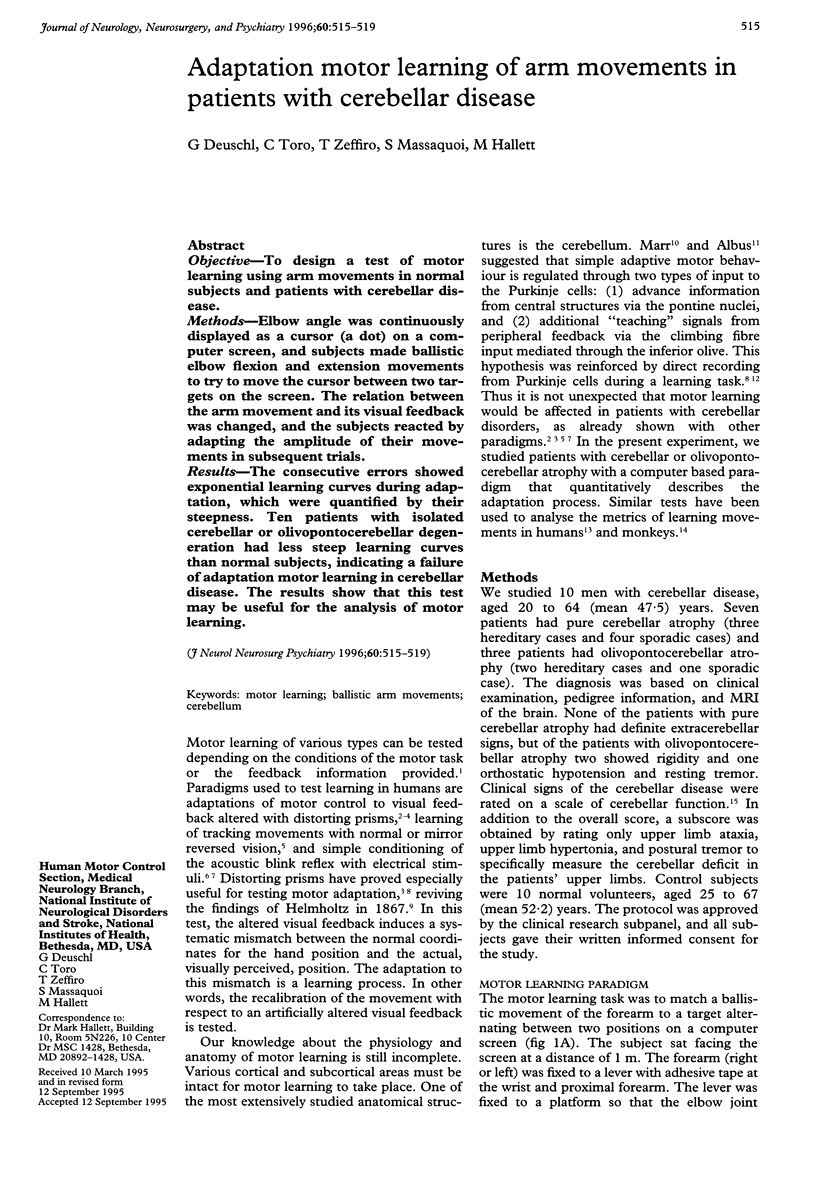
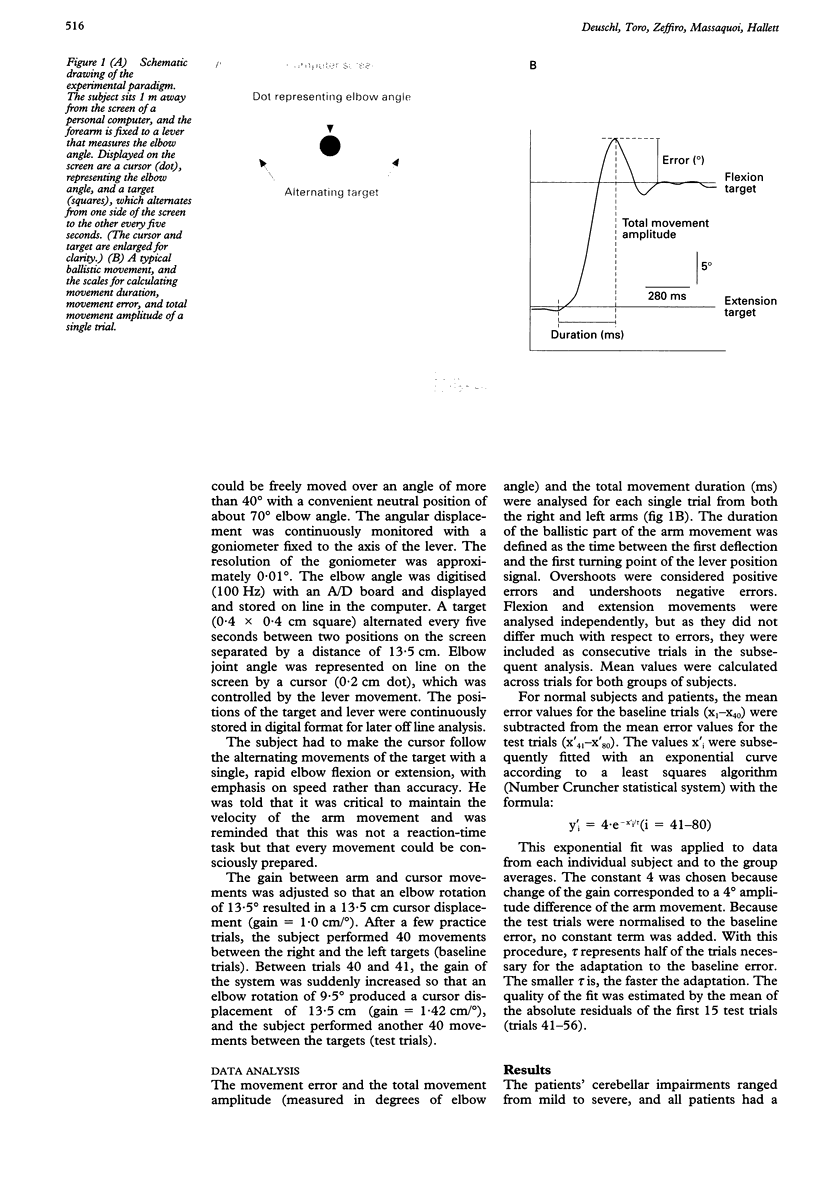
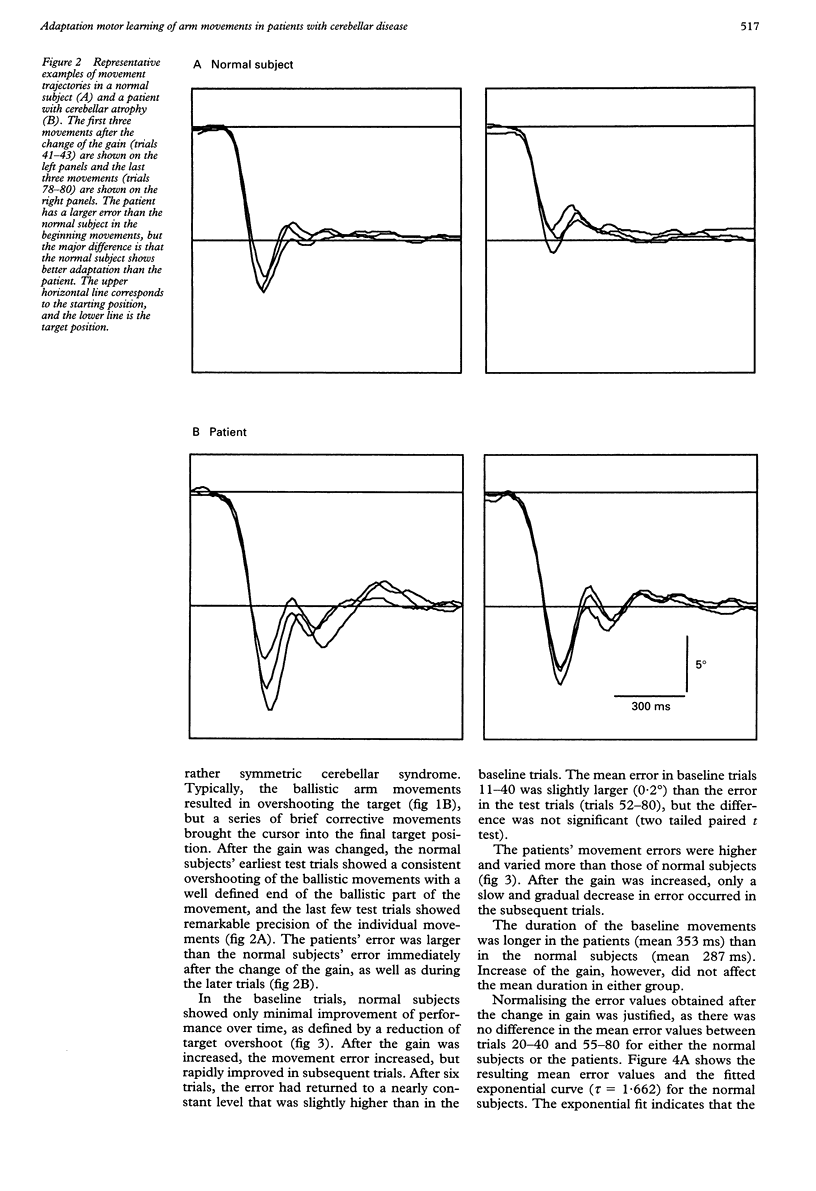
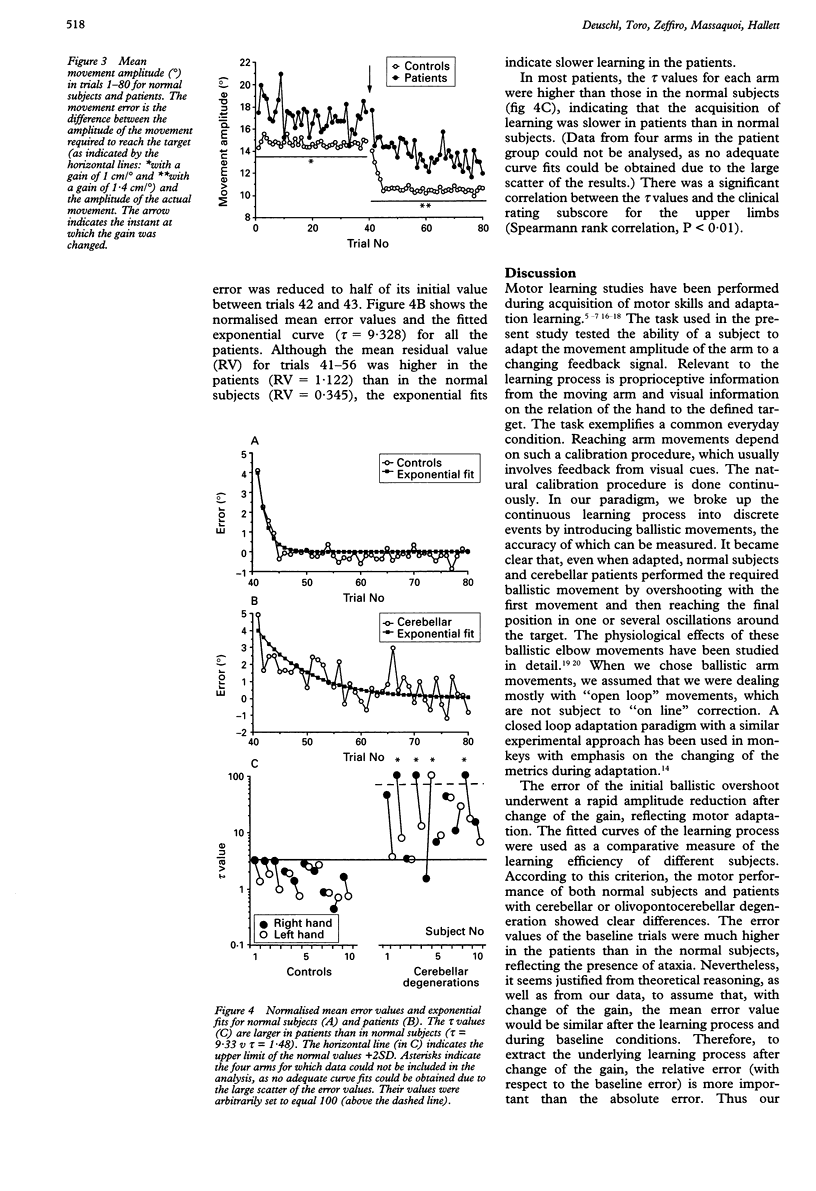
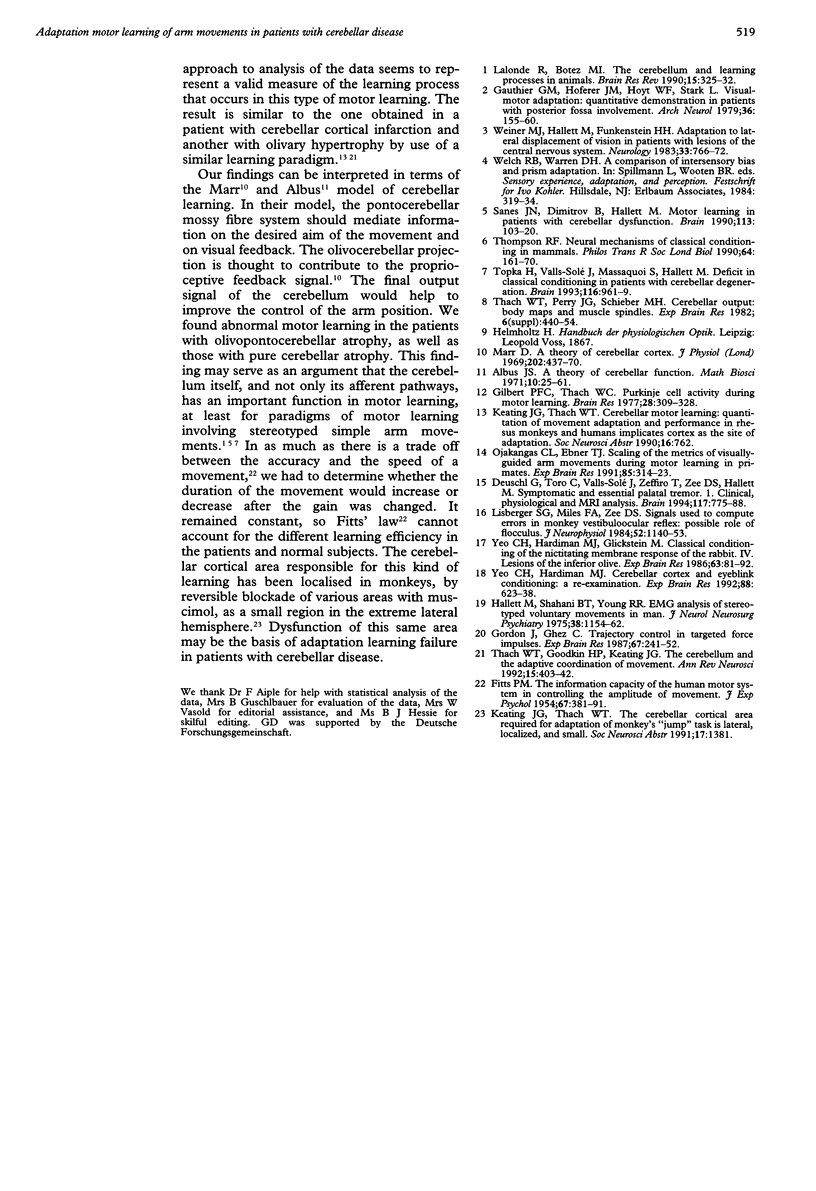
Images in this article
Selected References
These references are in PubMed. This may not be the complete list of references from this article.
- Deuschl G., Toro C., Valls-Solé J., Zeffiro T., Zee D. S., Hallett M. Symptomatic and essential palatal tremor. 1. Clinical, physiological and MRI analysis. Brain. 1994 Aug;117(Pt 4):775–788. doi: 10.1093/brain/117.4.775. [DOI] [PubMed] [Google Scholar]
- FITTS P. M. The information capacity of the human motor system in controlling the amplitude of movement. J Exp Psychol. 1954 Jun;47(6):381–391. [PubMed] [Google Scholar]
- Gauthier G. M., Hofferer J. M., Hoyt W. F., Stark L. Visual-motor adaptation. Quantitative demonstration in patients with posterior fossa involvement. Arch Neurol. 1979 Mar;36(3):155–160. doi: 10.1001/archneur.1979.00500390073008. [DOI] [PubMed] [Google Scholar]
- Gilbert P. F., Thach W. T. Purkinje cell activity during motor learning. Brain Res. 1977 Jun 10;128(2):309–328. doi: 10.1016/0006-8993(77)90997-0. [DOI] [PubMed] [Google Scholar]
- Gordon J., Ghez C. Trajectory control in targeted force impulses. II. Pulse height control. Exp Brain Res. 1987;67(2):241–252. doi: 10.1007/BF00248546. [DOI] [PubMed] [Google Scholar]
- Hallett M., Shahani B. T., Young R. R. EMG analysis of stereotyped voluntary movements in man. J Neurol Neurosurg Psychiatry. 1975 Dec;38(12):1154–1162. doi: 10.1136/jnnp.38.12.1154. [DOI] [PMC free article] [PubMed] [Google Scholar]
- Lalonde R., Botez M. I. The cerebellum and learning processes in animals. Brain Res Brain Res Rev. 1990 Sep-Dec;15(3):325–332. doi: 10.1016/0165-0173(90)90006-a. [DOI] [PubMed] [Google Scholar]
- Lisberger S. G., Miles F. A., Zee D. S. Signals used to compute errors in monkey vestibuloocular reflex: possible role of flocculus. J Neurophysiol. 1984 Dec;52(6):1140–1153. doi: 10.1152/jn.1984.52.6.1140. [DOI] [PubMed] [Google Scholar]
- Marr D. A theory of cerebellar cortex. J Physiol. 1969 Jun;202(2):437–470. doi: 10.1113/jphysiol.1969.sp008820. [DOI] [PMC free article] [PubMed] [Google Scholar]
- Ojakangas C. L., Ebner T. J. Scaling of the metrics of visually-guided arm movements during motor learning in primates. Exp Brain Res. 1991;85(2):314–323. doi: 10.1007/BF00229409. [DOI] [PubMed] [Google Scholar]
- Sanes J. N., Dimitrov B., Hallett M. Motor learning in patients with cerebellar dysfunction. Brain. 1990 Feb;113(Pt 1):103–120. doi: 10.1093/brain/113.1.103. [DOI] [PubMed] [Google Scholar]
- Thach W. T., Goodkin H. P., Keating J. G. The cerebellum and the adaptive coordination of movement. Annu Rev Neurosci. 1992;15:403–442. doi: 10.1146/annurev.ne.15.030192.002155. [DOI] [PubMed] [Google Scholar]
- Thompson R. F. Neural mechanisms of classical conditioning in mammals. Philos Trans R Soc Lond B Biol Sci. 1990 Aug 29;329(1253):161–170. doi: 10.1098/rstb.1990.0161. [DOI] [PubMed] [Google Scholar]
- Topka H., Valls-Solé J., Massaquoi S. G., Hallett M. Deficit in classical conditioning in patients with cerebellar degeneration. Brain. 1993 Aug;116(Pt 4):961–969. doi: 10.1093/brain/116.4.961. [DOI] [PubMed] [Google Scholar]
- Weiner M. J., Hallett M., Funkenstein H. H. Adaptation to lateral displacement of vision in patients with lesions of the central nervous system. Neurology. 1983 Jun;33(6):766–772. doi: 10.1212/wnl.33.6.766. [DOI] [PubMed] [Google Scholar]
- Yeo C. H., Hardiman M. J. Cerebellar cortex and eyeblink conditioning: a reexamination. Exp Brain Res. 1992;88(3):623–638. doi: 10.1007/BF00228191. [DOI] [PubMed] [Google Scholar]
- Yeo C. H., Hardiman M. J., Glickstein M. Classical conditioning of the nictitating membrane response of the rabbit. IV. Lesions of the inferior olive. Exp Brain Res. 1986;63(1):81–92. doi: 10.1007/BF00235649. [DOI] [PubMed] [Google Scholar]



